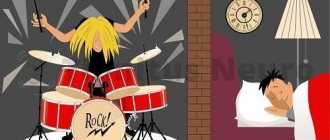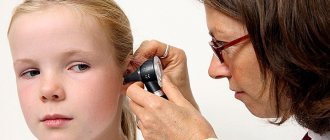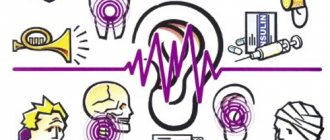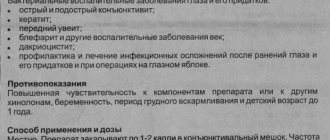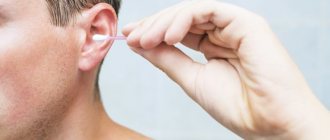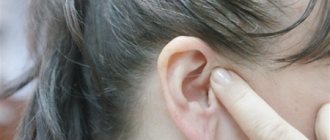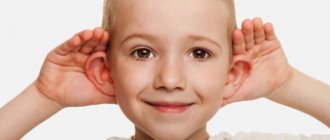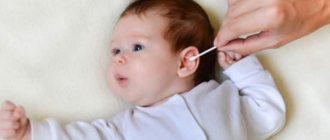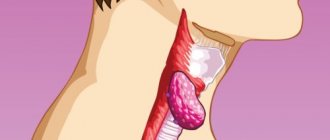Scientifically, the sensation of noise, whistling, ringing or buzzing in the ears is called tinnitus. Almost every person encounters it sooner or later. But sometimes this phenomenon turns out to be too uncomfortable, making it difficult to concentrate and creating problems in everyday life.
In order to understand what exactly happens at such a moment with the hearing organs, we will tell you further. So, why is there a ringing in the ear, what disease could this phenomenon be a symptom of, and how to respond to it?
About the different causes of tinnitus
Since hearing is very important for a person, helping to navigate in space, remember information, etc., the appearance of extraneous sounds of unknown origin, especially if they become permanent, forces us to look for the original source of the problem.
And it should be noted that there can be a lot of reasons why there is a ringing in the ear. And most often this happens if water gets into the ear canals or if a person has experienced a stressful situation. Tinnitus can occur after listening to loud music, or be a reaction to changes in weather or to a sudden change in atmospheric pressure (for example, when taking off an airplane or during diving).
Tinnitus appears as a result of fatigue, and after excessive physical exertion, and even due to the accumulation of wax in the ear canal (the so-called cerumen plug). But besides this, the described phenomenon may be a symptom of serious diseases.
Whistling in the head: causes and treatment
Whistling in the ears or in the head is another type of the most common extraneous noise that a person can hear for various reasons. According to statistics, approximately 85% of adult respondents periodically encounter various extraneous sounds in their heads or ears.
In most cases, tinnitus is not pathological. However, constant noise, including whistling in the head or ears, is a good enough reason to seek help from a specialist. During a medical examination, the doctor pays attention, first of all, to the duration, nature and frequency of noises.
As a rule, whistling in the ears and head appears:
- with previous hearing or head injuries (TBI);
- for some diseases of the endocrine system;
- with increased blood pressure;
- when the ear canal is blocked by cerumen;
- with ossification of the middle ear cavity;
- if the eardrum is damaged;
- in case of an acoustic shock, which can be caused by too loud a sound or frequent listening to loud music on headphones;
- when overworked;
- in case of an allergic reaction;
- with psycho-emotional shocks;
- with iodine deficiency;
- for injuries and diseases of the spine.
In addition, whistling can appear in old age or bother weather-sensitive people. This undesirable phenomenon primarily affects people who, due to their professional activities, are forced to deal with high levels of noise every day, which has a negative effect on the hearing aid.
It is believed that whistling in the head or ears may be a symptom of:
- diabetes mellitus;
- kidney pathologies;
- atherosclerosis or glandular sclerosis;
- hypertension;
- capillary lesions;
- hypoglycemia;
- mental illness;
- carotid artery aneurysm;
- hepatitis A;
- colds and viral diseases;
- otitis;
- acoustic neuritis;
- meningiomas;
- Meniere's disease;
- migraine;
- hypertension;
- osteochondrosis;
- arteriovenous malformation.
If whistling in the head or ears is accompanied by dizziness, painful sensations in the ears, nausea, a feeling of congestion, hearing loss (complete, partial), as well as signs of asthenia, then you should urgently seek medical help. Treatment for whistling in the head and ears is based on the underlying cause of the ailment and may include both drug treatment methods and physiological procedures.
Why is there a ringing in my left ear?
If a patient has a ringing in the ear, doctors may suspect an infection. For example, inflammation of the middle ear - the cavity located behind the eardrum. It contains three special bones (hammer, incus and stapes), which transmit sound vibration from the eardrum further to the cochlea (a tube with liquid), and with its help to the auditory nerve.
During inflammatory processes, swelling forms in the middle ear, and sometimes fluid accumulates, which reduces mobility, and at the same time the transmitting ability of these elements. All this leads to background noise, which explains why the right ear (or left) rings during otitis media. By the way, this disease is most often accompanied by painful sensations in the ear canal, its redness, purulent discharge from the ear, increased temperature and deterioration of hearing.
Traditional treatment
Traditional treatment is used to eliminate ringing in the ears. Before using any product, you should consult your doctor.
Onions are used as an antibacterial agent that can quickly eliminate the symptoms of inflammation of the middle ear. Prepare onion puree (first grate it), then soak a cotton ball in this mixture and place it in the ear for 2-3 hours.
Garlic turunts are also prepared in the same way. A few cloves of garlic are passed through a garlic press, or grated on a fine grater. Soak the turunta in the resulting mixture and place it in the ear for 1-2 hours.
A mixture of hare cabbage juice and plantain herb has also worked well. Herbs are taken in a 2:1 ratio and mixed. The juice is instilled into the ear, 1-2 drops 2-3 times a day.
Fir oil has worked well for ringing in the ears. You can soak a toothpick or match without cotton wool in undiluted essential oil, then pass the stick behind your ear. The oil will have a bactericidal effect and relieve inflammation. It should be used in very small quantities, since any pure oil is very active and can cause burns and inflammation.
Fir oil can be added to the base massage oil for light rubbing, massage, and compresses for the ear. For preparation, take approximately 50 ml of fatty base oil. It can be any vegetable oil: almond, peach, apricot. You can even take sunflower and olive oil. Add 1-2 drops of essential fir oil to it and mix thoroughly.
To use it as a compress, take gauze, soak it in the prepared mixture, squeeze it out so that the oil does not flow. Apply to the area around the ear: in front, behind the ear, on the ear lymph nodes, which can be felt in the form of protrusions. The gauze is covered with cellophane on top, which will provide a thermal and “greenhouse” effect.
Otosclerosis
Another reason why there is a ringing in the ear may be otosclerosis - a pathological growth of bone tissue in the labyrinth of one ear, which eventually passes to the other.
In most cases, this problem begins to develop already in adolescence, during puberty, and in girls the disease occurs 2 times more often than in boys. By the way, a reliable cause of the pathology has not yet been established, although researchers have reason to believe that otosclerosis can be triggered by dysfunction of the endocrine glands during adolescence, as well as by exposure to loud music on hearing, which teenagers are very fond of.
But, be that as it may, this disease leads to the appearance of painful ringing in the ears and serious hearing loss. Interestingly, such patients hear better in a noisy environment (somewhere in transport, on the street or even in a workshop) than in a quiet room.
When we hear ringing in our ears
Unfortunately, there are many other explanations for ringing in the ears. This symptom can constantly haunt people with various diseases, being one of the signs of a developing disease. And it should be noted that most often these turn out to be some kind of vascular pathologies, although inflammatory processes are also not uncommon, which can cause not only tinnitus, but even hearing loss.
And in this way, our hearing organs can signal metabolic disorders, for example, thyroid dysfunction, problems with the cervical spine, pathologies of the mandibular and temporal joints, as well as the presence of neoplasms in the head or neck area or a tumor (the so-called neuroma ) of the auditory nerve itself, which, squeezing it, causes severe tinnitus.
Constant whistling in the ears and head
There is a physiological form of noise.
The following form of extraneous sounds is caused by pathological causes:
- vasoconstriction;
- allergy;
- hypertension, etc.
The eardrum begins to move due to any vibration. The hammer catches it and two variations are obtained relative to each other. The signal is transmitted to the cochlea, which, in turn, moves the fluid. The process is continued by the hairs in it. The electrical impulse created by the hairs is transmitted to the auditory nerve. Next comes the conversion of the received impulse into sound.
Hairs can be damaged during a head injury, through loud music or machines. The consequences may be their separation or bending. Hence, there will be no signal transmission to the auditory nerve from the hairs.
Damaged hairs can have the opposite effect - vibrate constantly. Here the patient will hear a non-existent sound.
The nature of the sound serves to determine the diagnosis and prescribe treatment. The patient must clearly know what he hears.
In this case, sounds can be intense, weak, strong, prolonged and vice versa.
A group of diseases contribute to dizziness and noise in the head, among them are:
- Meniere's disease. Symptoms of the disease are caused by fluid that collects in the inner ear and puts pressure on its tissues. As a result, the patient feels pain with attacks of dizziness and nausea.
- A brain tumor.
- A concussion is accompanied by dizziness.
- Hypertonic disease.
- Osteochondrosis of the cervical vertebra. Due to compression of the vertebrae, the brain does not receive enough oxygen and nutrients. Symptoms of the disease in this case may include dizziness, headaches, noise in the ear, and unsteadiness of gait.
- Intoxication.
- Damage to the cerebellum.
- Sulfur plug.
- Nervous exhaustion.
- Pregnancy is often accompanied by dizziness, but after the birth of the child everything goes away.
- Atherosclerosis.
- Sensorineural hearing loss. The noise can occur alternately in one ear or the other or in both at once.
- Vegetovascular dystonia.
- Taking medications (anti-inflammatory drugs - Zamperik, Salicylates, Tolmetin, Quinine; antibiotics - Aminoglycosides, Dapsone, Vibramycin; cardiovascular drugs - B-blockers, Digitalis.)
Vascular diseases causing tinnitus
Listing the diseases, the presence of which may be the answer to the question of why there is ringing in the ears and head, first of all it is worth mentioning hypertension, which is unfortunately common today.
As a rule, this symptom accompanies an increase in blood pressure. And if it is also accompanied by a headache, spots before the eyes, pain in the heart and nausea, you should call an ambulance, since with a high probability we are talking about a hypertensive crisis that can provoke a stroke.
By the way, a consequence of existing hypertension may be stenosis (narrowing) of cerebral vessels. It is also accompanied by noise and ringing in the ears, which, by the way, is practically the only symptom in the early stages of this disease. And other clinical signs are detected only when stenosis already covers up to 70% of the vessels and threatens the development of stroke, myocardial infarction and other serious consequences.
Physiotherapeutic treatment
For ringing in the ears, various physical procedures can be used, depending on the underlying disease. Ultrasound is often used, which promotes deep heating of tissues, disinfects, and removes the source of inflammation and infection.
Infrared radiation makes it possible to resist the spread of infectious and inflammatory processes, resolves exudates, small hematomas, and strengthens the walls of blood vessels.
Various thermal procedures are used that promote deep penetration of thermal radiation into tissues, thereby providing a powerful therapeutic effect. Hyperemia, pain, and inflammation can be significantly reduced under the influence of thermal radiation, as a result of which the ringing in the ears will disappear.
Electrical procedures stimulate various receptors and can have a positive effect in the treatment of inflammation of the inner ear and other diseases. The main effect is achieved through the action of non-biologically active points, receptors. The ringing occurs as a secondary pathology.
Sensorineural hearing loss
The condition of the blood vessels is perhaps one of the most common causes of the described symptom. For example, the answer to the question “why do my ears ring all the time” may lie in existing sensorineural hearing loss.
And the main condition for its development is the presence of atherosclerosis - obstruction of the smallest vessels that supply blood to the inner ear. Because of this, the nutrition of the smallest villi that line the inside of the cochlea wall and perceive sound vibrations to transmit them further to the auditory nerve is disrupted. These villi die, which ultimately leads to distorted perception of sounds and constant tinnitus.
And although this pathology is characteristic mainly of older people, it can also develop in younger patients as a result of illness or the use of antibiotics, which will be listed below.
Treatment of ear problem
It is impossible to imagine modern medicine without the use of pharmacological drugs. Medicines, which are produced in various forms, can be administered in a hospital setting and prescribed for outpatient use. However, some of them can have a toxic effect on the organ of hearing - that is, they have ototoxic properties.
| Group of drugs | Representatives | Ototoxic effect | Peculiarities |
| Aminoglycosides | Gentamicin, Streptomycin, Neomycin | They cause spasm of the stria vascularis, provoke disruption of microcirculation and nutrition of the spiral ligament and spiral organ. | In a comparative assessment of ototoxicity, Gentamicin has a more pronounced toxic effect than Streptomycin. |
| Loop diuretics | Furosemide, Ethacrynic acid, Bumetanide | They provoke a decrease in the excitability of the cochlea. | The likelihood of an ototoxic effect increases when taking high doses of the drug or combined use with drugs that also have ototoxicity. |
| Salicylates | Acetylsalicylic acid, Sodium salicylate | They damage outer hair cells and can accumulate in the stria vascularis. | Deterioration of hearing acuity occurs when high doses are used. With timely discontinuation of the drug, hearing loss is reversible. |
| Platinum preparations | Cisplatin | The exact mechanism is unknown; researchers note accumulation of the drug in the stria vascularis, basilar membrane and vestibular part of the cochlea. | Hearing damage may occur even with a single use. |
| Antimalarial drugs | Chloroquine | Snail damage. | Shows ototoxic effects when the dose is significantly exceeded. |
The table shows the drugs that are prescribed for various pathologies. The presence of ototoxicity does not determine refusal of them, but requires caution and compliance with all recommendations received during consultation at a medical institution. If you experience whistling in the ears while taking the medication, you should immediately inform your doctor.
The ototoxic effect of aminoglycosides persists for some time even after discontinuation of the drug.
In order to prevent ototoxicity, aminoglycoside antibiotics are not prescribed to young children and pregnant women - except for vital indications. The need to justify the prescription is one of the principles of application. In addition, you need to monitor the patient's condition, checking for tinnitus and dizziness daily. This allows you to timely clarify the causes of whistling in the left ear or in both ears.
How to get rid of noise in the left ear? Before you begin complex treatment, you need to accurately determine the problem that leads to these symptoms. To do this, you should undergo diagnostics using electronic equipment (audiometry) for medical purposes.
In addition to the main reasons, there may also be accompanying ones, if a person’s activity (work) is associated with strong noise (in a factory, workshop, etc.) or if such a reaction occurred after a course of taking strong antibiotics. After this, we can talk about the development of auditory neuritis.
The following methods are used to treat ear problems:
- medications;
- magnetic therapy;
- electrical stimulation;
- reflexology.
Depending on the degree of neglect of the disease and the cause of its occurrence, you can combine medications with the required procedures. In some situations, you can limit yourself to taking anti-inflammatory drugs, and sometimes you cannot do without complex surgical intervention.
With such a complication as tinnitus, various physiotherapeutic methods of treatment and prevention have been used, which are based on the use of any medical devices tailored to this problem.
Current physiotherapeutic methods for eliminating noise and whistles in the left ear are:
- Massage of the eardrum, which eliminates not only noises and whistles, but also the side effects of this condition that may bother a person. These side symptoms include dizziness, ear congestion, migraines, fatigue and hearing loss.
- Therapy with weak electric currents, which have a beneficial effect on the functioning of the potassium-sodium pump, balancing its functional properties, resulting in the improvement of many processes in the body, including auditory activity.
- Iontophoresis - this method is based on the introduction of medications into the body tissues through electrolysis, which is formed due to the action of galvanic current.
The presented methods were amenable to careful study and testing of the effect on problematic symptoms; as a result of comparisons and experimental methods, it was found that it is precisely such physiotherapeutic interventions that give a positive result and relieve the patient from annoying noise and whistling in the ears.
Various infusions and decoctions will help overcome ailments associated with noise and whistling in the left ear.
To do this you need to do the following:
- Infuse lemon balm in boiling water for half an hour, then strain the broth and take twice a day for several weeks.
- Dried dill is taken per liter of boiling water and infused for about one hour, taken before meals, until the result is obvious (ear disorders begin to subside or even minutes).
- Recently, some patients also prefer massages, during which the necessary organs are affected while correctly identifying the points responsible for a particular disease.
If you are faced with a problem such as noise or whistling in your ears, and it doesn’t matter at all whether it’s in the left or right, you should immediately seek advice from a specialized doctor. Ignoring emerging symptoms and delaying treatment can not only lead to pain and constant insomnia, but also to the development of deafness in the future.
What does pulsating tinnitus mean?
By the way, you should know that doctors consider the so-called “pulsating” tinnitus a dangerous symptom. It coincides with the pulse and is most often a sign of some vascular abnormality, such as an aneurysm or vascular malformation.
An aneurysm is a thinning of the walls of blood vessels, and a malformation is an improper connection between them. Both of these conditions are very dangerous, as they can lead to rupture at any moment. And from this it follows that with a constant pulsating noise, it would be more correct not to think about why the ear is ringing, but to urgently contact a specialist for an examination.
Diagnosis of the disease
If the noise in the left ear intensifies or symptoms appear in the right ear, then it is necessary to urgently consult an ENT specialist. It is also worth doing this if you experience severe dizziness and headaches. After examining the patient, the doctor will tell you about the causes of the disease, prescribe the necessary diagnostic methods, and, if necessary, refer you to additional specialists.
Types of diagnostics:
- During a routine examination by an ENT specialist, the ear is checked using special instruments. With this method, the doctor checks whether there are any foreign bodies, wax plugs or otitis media.
- Computed tomography and magnetic resonance imaging can be used to determine the presence of various tumors of the auditory nerve.
- Audiometry evaluates the acuity and various performance indicators of the hearing aid. Using this method, hearing loss can be detected.
- You can also visit a neurologist, but this is done if you have symptoms that are characteristic, for example, of brain tumors.
How to prevent diseases that cause tinnitus?
All of the problems listed, and those that were not mentioned, are serious enough that a sane person would try to prevent their occurrence. And for this it is important:
- protect your ears from loud noise;
- regularly clean them of wax plugs;
- avoid high cholesterol and blood sugar - conditions leading to atherosclerosis;
- fight high blood pressure;
- with caution and only under the supervision of a doctor, take drugs that can have a negative effect on the condition of the villi, for example, Kanamycin, Gentamicin, Streptomycin, Cisplattin or Furosemide and others that are ototoxic.
And of course, don’t guess why your ears sometimes ring, and if these symptoms appear, go for a consultation with a specialist as soon as possible.
